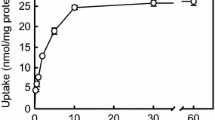Abstract
This study deals with the electrical responses of the peritubular membrane of the Necturus proximal tubule to 8 organic anions, in NaHCO3-free (trismaleate-buffered) and NaHCO3-containing solutions. The anions glutamate and gluconate brought about a small depolarization, but only in NaHCO3-free media. Benzene sulfonate did not alter significantly membrane p.d. The 5 other test-anions produced hyperpolarization. The magnitude of membrane depolarization elicited by high-K media was proportionally larger in the presence of the test-anions propionate, lactate, pyruvate, acetate and formate than with chloride: it is inferred that these anions increasedT K. The same 5 anions shifted in the negative direction the p.d. achieved at peak K-depolarization; according to a previous analysis (Anagnostopoulos, 1977), this observation suggests that their permeabilities (P A) are greater thanP Cl, at least during the substitution. The association ofP A>P Cl with an increase ofT K, upon exposure of the kidney to test-anions, is at best accounted for by a decrease ofP Cl. The pattern of voltage attenuation along the epithelial cable during anionic substitutions is also consistent with an increase ofT K via a decrease ofP Cl. In conclusion, the apparent sequence of relative anionic permeabilities, as obtained from the responses of the tissue to a single anion, irrespective of buffering procedures, is:P acet,P lact,P pyruv,P prop,P form>P Cl≃P gluc,P glut. The test-anions propionate, lactate, pyruvate, acetate and formate tend to increaseT K, mainly by reducingP Cl. The effect of glutamate and gluconate on physiologic ion permeabilities is too small to be specified with accuracy: it depends to some extent on the buffer used in the solutions.
Similar content being viewed by others
References
Anagnostopoulos, T.: Biionic potentials in the proximal tubule of Necturus kidney. J. Physiol. (Lond.)233, 375–394 (1973)
Anagnostopoulos, T.: Anion permeation in the proximal tubule of Necturus: the shunt pathway. J. Membr. Biol.24, 365–380 (1975)
Anagnostopoulos, T.: Electrophysiological study of the antiluminal membrane in the proximal tubule of Necturus: effect of inorganic anions and SCN−. J. Physiol. (Lond.)267, 89–111 (1977)
Anagnostopoulos, T., Teulon, J., Edelman, A.: Is the coupling of proximal tubular cells voltage-dependent? p. 95A. Washington, D.C.: Proc. 10th Ann. Meet. Am. Soc. Nephrol. 1977
Boulpaep, E. L.: Ion permeability of the peritubular and luminal membrane of the renal tubular cell. In: Transport und Funktion intracellulärer Elektrolyte (F. Kruck, ed.), pp. 98–105. München: Urban & Schwarzenberg 1967
Boulpaep, E. L., Steels, P. S.: Electrophysiolohical study of the Necturus proximal tubule: effects of organic substrates and segmental heterogeneity. In: Electrophysiology of the nephron. (T. Anagnostopoulos, ed), pp. 127–134. Paris: INSERM Editions 1977
Diamond, J. M., Wright, E. M.: Biological membranes: the physical basis of ion and non-electrolyte selectivity. Ann. Rev. Physiol.31, 581–646 (1969)
Edelman, A., Anagnostopoulos, T.: Transepithelial potential difference in the proximal tubule of Necturus kidney. Pflügers Arch.363, 105–111 (1976)
Eisenman, G.: Some elementary factors involved in specific ion permeation. Proc. Int. Union Physiol. Sci.4, 489–506 (1965)
Giebisch, G.: Measurements of electrical potential differences on single nephrons of the perfused Necturus kidney. J. Gen. Physiol.44, 659–678 (1961)
Grandchamp, A., Boulpaep, E. L.: Pressure control of sodium reabsorption and intercellular backflux across proximal kidney tubule. J. Clin. Invest.54, 69–82 (1974)
Hoppe, A., Gmaj, P., Metler, M., Angielski, S.: Additive inhibition of renal bicarbonate reabsorption by maleate plus acetazolamide. Am. J. Physiol.231, 1258–1262 (1976)
Khuri, R., Agulian, S. K., Bogharian, K., Aklanjian, D.: Electrochemical potentials of chloride in proximal renal tubules of Necturus maculosus. Comp. Biochem. Physiol.50A, 695–700 (1975)
Khuri, R., Hajjar, J. J., Agulian, S., Bogharian, K., Kalloghlian, A., Bizri, H.: Intracellular potassium in cells of the proximal tubule of Necturus maculosus. Pflügers Arch.338, 73–80 (1972)
Spring, K. R.: Electrical properties of the Necturus proximal tubule. In: Electrophysiology of the nephron (T. Anagnostopoulos, ed.), pp. 161–182. Paris: INSERM Editions 1977
Spring, K. R., Kimura, G.: Chloride reabsorption by renal proximal tubules of Necturus. J. Membr. Biol.38, 233–254 (1978)
Author information
Authors and Affiliations
Rights and permissions
About this article
Cite this article
Anagnostopoulos, T., Planelles, G. Organic anion permeation at the proximal tubule of Necturus. Pflugers Arch. 381, 231–239 (1979). https://doi.org/10.1007/BF00583254
Received:
Accepted:
Issue Date:
DOI: https://doi.org/10.1007/BF00583254




